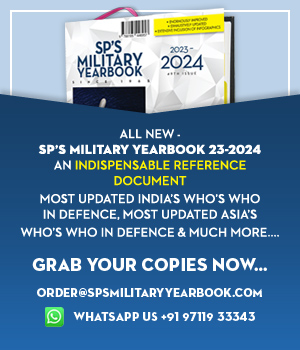INDIAN ARMED FORCES CHIEFS ON OUR RELENTLESS AND FOCUSED PUBLISHING EFFORTS

The insightful articles, inspiring narrations and analytical perspectives presented by the Editorial Team, establish an alluring connect with the reader. My compliments and best wishes to SP Guide Publications.

"Over the past 60 years, the growth of SP Guide Publications has mirrored the rising stature of Indian Navy. Its well-researched and informative magazines on Defence and Aerospace sector have served to shape an educated opinion of our military personnel, policy makers and the public alike. I wish SP's Publication team continued success, fair winds and following seas in all future endeavour!"

Since, its inception in 1964, SP Guide Publications has consistently demonstrated commitment to high-quality journalism in the aerospace and defence sectors, earning a well-deserved reputation as Asia's largest media house in this domain. I wish SP Guide Publications continued success in its pursuit of excellence.
MODERNISATION / SUBMARINES
India’s Submarine Capability and Roadmap: Track for 2035
Indian Navy’s submarine modernisation plan is multi-pronged and spans across diesel-electric (SSK), nuclear-powered ballistic missile (SSBN), and nuclear-powered attack (SSN) submarines. The navy’s modernisation plan has multiple strategic and rational elements for India’s maritime doctrine of sea denial, sea control, and credible minimum deterrence. The plan also takes into account China’s expanding naval footprint in the Indian Ocean and the People’s Liberation Army Navy’s rapid submarine buildup.

India’s submarine modernisation is a strategic national security initiative aimed at deterring regional threats, ensuring maritime dominance in the Indian Ocean, and bolstering the country’s second-strike nuclear capability. The plan is multi-pronged and spans across diesel-electric (SSK), nuclear-powered ballistic missile (SSBN), and nuclear-powered attack (SSN) submarines.
The navy’s modernisation plan has multiple strategic and rational elements, which include China’s expanding naval footprint in the Indian Ocean and the People’s Liberation Army Navy (PLAN) rapid submarine buildup. PLAN is expected to grow its submarine force to 65 boats by 2025 and 80 by 2030, according to United States government reports. This expansion includes both nuclear-powered attack submarines (SSNs) and ballistic missile submarines (SSBNs), as well as a robust diesel-electric submarine (SSK) fleet.
At the same time, Pakistan’s modernisation of its submarine fleet (Agosta-90B upgrades, Hangor-class under construction) poses challenges on the back of China’s overt support.
However, the depletion of Indian conventional sub strength is also factored from 21 in the 1980s to 15 (2024), while many are ageing.
The submarine modernisation plan includes the need for a credible sea-based nuclear deterrent as part of India’s nuclear triad.
India’s submarine modernisation programmes have been categorised broadly in Projects like Project 75 (P-75), P-75(I), SSBN, SSN, and associated upgrade plans. How is it unfolding?
Project 75 (P-75) – Kalvari-Class Diesel-Electric Submarines
Six Scorpene-design submarines were built at Mazagon Dock Ltd (MDL) with Naval Group (France), as part of the original P-75 programme.
In the series, the lead boat, INS Kalvari, was commissioned in December 2017. INS Vagir (5th boat) was commissioned in January 2023 and the final boat, INS Vagsheer, launched in April 2022, was officially commissioned into the Indian Navy on 15 January 2025.
These subs feature modern stealth features and missions from anti-submarine warfare (ASW) to mine-laying. They have faced delays and weapons (Black Shark torpedo) delivery issues due to vendor issues and blocklisting policies.
Moreover, the planned additional three Scorpène boats (P-75 Additional) are under final negotiation for construction at MDL to boost fleet numbers.
Project-75 (India) – Next-Generation Diesel-Electric Subs with AIP
The next phase of the Indian Navy submarine plan is categorised as P-75(I). Approved for six stealth diesel-electric submarines, to be built under “Make-in-India” collaboration between MDL and TKMS (Germany), bid passed technical evaluation in early 2025.
TKMS-MDL bid was the sole compliant offer. It incorporates the AIP, which is likely German fuel-cell-based, verticallaunch capability for cruise missiles, high indigenous content, and extended submerged endurance. The first boat is expected in the mid-2030s (seven-sevenyear build timeline for the lead hull). It is expected that the entire class will be delivered by the mid-thirties.
At the same time, the life-extension of ageing Shishumar (HDW Type 209) class: INS Shishumar and INS Shankush mid-life upgrades are underway at MDL, extending service by 10–15 years, finishing around 2026.
Nuclear Ballistic Missile Submarines (SSBNs – Arihant/Arighat/Aridhaman/S5)
India’s first SSBN, INS Arihant, was launched in July 2009 and commissioned in August 2016. It was operationalised in 2018. INS Arihant is a 6,000-tonne class sub with 4× K-15 SLBMs (750 km range).
Second SSBN, INS Arighaat (S3) was commissioned in 2024, boosting indigenisation as estimated at around 70 per cent. Arighaat is the same 6,000-tonne with CLWR reactor, carries up to 4× K-4 SLBMs (3,500 km range) or more K-15s mixed load.
The third Arihant-class submarine, INS Aridhaman (S4) of about 7,000-tonnes, is undergoing sea trials. Aridhaman is expected to be inducted in 2025. It has 8 missile tubes and can carry up to 8 K-4 or longerrange K-5 SLBMs (~6,000 km).
The fourth unit, codenamed S5 (loosely referred to) is also under construction at Visakhapatnam, with an upgraded reactor and expanded SLBM capacity.
S5-class SSBNs: Larger advanced nextgen SSBNs have an estimated 13,500-tonne, to begin production by 2027. The SSBN is powered by a 190 MW reactor from BARC. In terms of its capability, it is reported that the S5-Class could carry up to 12–16 K-5/K-6 SLBMs with MIRV capability.
Building further on this, the construction of up to six S5 boats in phases is planned to bolster credible nuclear deterrence.
Nuclear Attack Submarines (SSNs/‘Hunter-Killers’)
India’s lease of Akula-class SSN (INS Chakra III) ended in 2021. A new lease from Russia is expected to start in 2025/2026 while domestic SSNs develop.
The Cabinet Committee approved the first two indigenous SSNs in late 2024/early 2025 at the estimated cost of ₹45,000 crore ≈ $5.4 billion).
Navy Chief announced the first SSN to be ready by 2036, the second within two years thereafter. As per the re-opted plan, the Navy has marked its target of six SSNs over the next decade or so.
These SSNs are envisioned to be faster, quieter, longer-endurance platforms equipped with torpedoes, anti-ship and land-attack missiles, and potentially autonomous drones.
Strategic Context & Challenges
India’s submarine fleet modernisation is essential against the backdrop of expanding Chinese & Pakistani naval presence in the Indo-Pacific and Indian Ocean region.
However, in the crucial thread, the delays in P-75(I) stem from ambitious technical demands (e.g. stealth + AIP + vertical launch, etc.) in addition to strict liability and technology transfer clauses, and an unwillingness from many OEMs to meet the full suite of NSQRs. It was only in early 2025 that the government gave the green light to the MDL–TKMS bid, as the only compliant offer.
Filling shortfalls in diesel-electric numbers is also being managed via upgrades to Shishumar-class boats via mid-life refits to extend operational life through the 2030s.
Despite the foreign collaboration, indigenisation remains a core policy goal. SSBN/SSN/AIP subs aim for high local content as part of “Make-in-India,” though component sourcing and readiness timing pose perennial challenges. India is executing a multi-pronged, multi-decade submarine modernisation plan. The P-75 Programme is complete, with six diesel-electric Scorpènes already inducted.
P-75(I) holds promise for a leap forward with AIP-equipped SSKs, but is delayed and now firmly anchored to the TKMS–MDL pathway.
The SSBN fleet continues to grow with Arighat and Aridhaman entering service soon. INS Aridhaman, India’s third Arihantclass submarine, is expected to be commissioned into the Indian Navy by the end of 2025. Currently, Aridhaman is undergoing sea trials. Further, the next-generation S5 class will deliver expanded SLBM payloads and longer endurance.
The long-term goal is to field a fleet of six indigenous SSNs, with the first boat targeted for 2036 to support hunter-killer operations. Interim leasing of Russia’s Akula-class will bridge capability gaps. This programme is ambitious, strategic, and essential. The modernisation plans to combine legacy upgrades, foreign collaboration, and growing indigenous industrial capabilities to ensure credible undersea deterrence and strategic depth through the 2035s.
India aims to possess a triad-capable SSBN fleet and field advanced SSNs to counter Chinese and Pakistani submarines.
Additionally, it is geared to modernise and expand its diesel-electric fleet with AIP and missile capabilities and develop selfreliant technologies like AIP, nuclear propulsion, and SLBMs.
This effort is central to India’s maritime doctrine of sea denial, sea control, and credible minimum deterrence in an evolving Indo-Pacific security environment.
India’s Submarine Capability
| Programme | Type | Boats | Key Features/Status |
|---|---|---|---|
| P-75 (Kalvari) | Conventional (SSK) | 6 Scorpènes | Last Inducted in 2025; advanced stealth; facing weapons delivery delays |
| P-75(I) | Conventional (SSK + AIP) | 6 planned | German TKMS design; AIP; vertical missiles; indigenisation; delays |
| Arihant-class | SSBN | Arihant, Arighat, Aridhaman, S4(4 total) | Nuclear deterrent force; SLBMs K-15, K-4, upcoming K-5 |
| S5‑class | Advanced SSBN | Up to 6 planned | 13,500t; 190 MW reactor; 12–16 K-5/K-6 MIRV missiles; from ~2027 |
| SSN programme | Nuclear attack (hunter-killer) | 6 planned | 2 approved so far; first ready by 2036; leased Akula until then |
AIP: Air Independent Propulsion system





